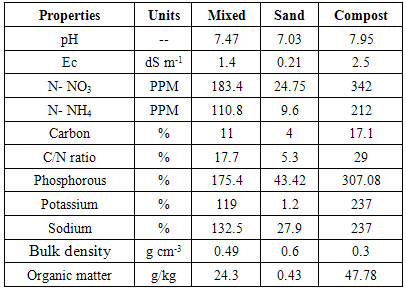-
Paper Information
- Paper Submission
-
Journal Information
- About This Journal
- Editorial Board
- Current Issue
- Archive
- Author Guidelines
- Contact Us
International Journal of Plant Research
p-ISSN: 2163-2596 e-ISSN: 2163-260X
2015; 5(1): 1-6
doi:10.5923/j.plant.20150501.01
Strawberry (Fragaria ananassa Duch.) Plant Productivity Quality in Relation to Soil Depth and Water Requirements
Basel Natsheh1, 2, Nawaf Abu-Khalaf1, 2, Sami Mousa2
1Technical and Applied Research Center, Palestine Technical University-Kadoorie (PTUK), Tulkarm, Palestine
2Faculty of Agricultural Sciences and Technology, Palestine Technical University-Kadoorie (PTUK), Tulkarm, Palestine
Correspondence to: Basel Natsheh, Technical and Applied Research Center, Palestine Technical University-Kadoorie (PTUK), Tulkarm, Palestine.
| Email: |  |
Copyright © 2015 Scientific & Academic Publishing. All Rights Reserved.
The cultivated strawberry (Fragaria ananassa Duch.), a member of the Rosaceae, is the most important soft fruit worldwide. The effect soil types and depth on strawberry yield in a greenhouse as well as its association with water management are still not well known. The aim of this work was to evaluate the effect of different soil depth and water requirements on strawberry plant yield and quality in a greenhouse. The experiment was carried in a greenhouse at Thennaba farm, Tulkarm, located in the West Bank, Palestine during the autumn and spring seasons of 2012/2013. The experimental design was a completely randomized design included two groups (Set A & Set B) in the green house half dunum (10 dunum = 1ha) for each Set, contains 20 rows and 3000 plants with two different soil depths 15 and 7 cm for A and B, respectively. The results showed that the strawberry plant productivity was higher in set (B) with 7 cm soil depth: was 2115 kg in comparing with set (A) 15 cm soil depth: was 1645 kg for the agricultural season. The water requirements was higher in set (A) (314 m3/ agricultural season) in comparison with Set (B) (193 m3/ agricultural season) during the nine months of agriculture period. It means that the soil depth gives directly effects on water requirements.
Keywords: Strawberry, Soil depth, Productivity, Water requirements, Quality
Cite this paper: Basel Natsheh, Nawaf Abu-Khalaf, Sami Mousa, Strawberry (Fragaria ananassa Duch.) Plant Productivity Quality in Relation to Soil Depth and Water Requirements, International Journal of Plant Research, Vol. 5 No. 1, 2015, pp. 1-6. doi: 10.5923/j.plant.20150501.01.
Article Outline
1. Introduction
- Strawberry (Fragaria ananassa Duch.) is one of the most delicious and fragrantly sweet flavored fruits of the world, very popular in many countries [1]. Growing strawberry in Palestine started in 1976. The area in which strawberry was grown was about 1-2 dunums (1 dumum = 0.1 ha). The growing of strawberry aimed to: studying how successful is planting strawberry according to climate, soil and irrigation water and studying how acceptable is the crop to the farmer. The situation continued as it as was until 1971. At that time, planting strawberry was mainly planted in the north Gaza where water (less than 250 ppm chloride) and soft sandy soil are available. The crop continued to be planted in the north of Gaza till the arrival of the Palestinian authority in Gaza Strip, 1993. After the arrival of Palestinian authority, nearly 30 dunums were planted with straw berry in Rafah and Khan Yunus, Especially in Al- Mawasi area [2].Strawberry (Fragaria ananassa Duch.) is a crop which is cultivated in greenhouse in West Bank, Palestine. Therefore, developing new methods to increase its yield and quality can play an important role in improving the performance of strawberry greenhouses. One of the modern soil cultivation methods is organic method. The later has some advantages such as control of crop nutrition, the capacity to increase planting density, decreasing diseases and pests and increasing the quantity and quality of the product have attracted many growers [3].Fruit quality is also affected by agro technical treatments, i.e. mulching, irrigation, chemical protection, fertilization, and before establishing a plantation: crop rotation and intercropping, proper preparation of the field, planting date, or the health status and type of seedling [4, 5]. There are two main functions of the mulch used in the cultivation of strawberry, to provide a barrier between the ground and the plants so that the berries will be kept from getting dirty, and to isolate them as much as possible from becoming infected with pathogenic fungi that cause the benies to rot [6]. The addition of organic mulch can increase enzyme activity, but can also decrease microbial biomass [7]. Whereas, the application of vermicompost increases dehydrogenase activity and microbial [8].Soil quality may be inferred from measurable soil properties termed soil quality indicators [9]. Organic farming practices compared to conventional farming practices have been shown to improve soil quality indicators based on traditional measures of biological, chemical, and physical properties [10-12].Proper irrigation of strawberries is essential to maintain a healthy and productive planting. Excessive soil moisture promotes root rot, particularly on heavy soils. Applying insufficient irrigation water results in drought stress. Drought stress during fruit development results in a reduced fruit size and yield, and poorer fruit quality. The goal of a well-managed irrigation program is to maintain soil moisture between field capacity and the point of allowable depletion, or in other words, to make sure that there is always readily available water. The amount of readily available water is related to the effective rooting depth of the plant, and the water holding capacity of the soil [13]. Straw is the most popular mulch used in Poland for strawberry production, but synthetic mulches e.g. polyethylene films are also used [14]. Similar studies have also been carried out in other countries with the use of natural mulches [15, 16] and also biodegradable films of organic origin [17-19]. Due to the importance of strawberry for the local farmers, it is essential to investigate the factors affecting productivity and quality of this crop. The objective of this work was to evaluate the effect of soil depths, types and water requirements on strawberry productivity and quality.
2. Materials & Methods
- The experiment was carried in a greenhouse at Thennaba farm, Tulkarm, located in the west bank, Palestine, during the autumn and spring seasons of 2012/2013. The experiment was a completely randomized design included two groups Set (A) & Set (B) in the green house half dunum (10 dunum = 1 ha) for each Set, contains 20 rows (replicates) and 3000 plants. Mixed soil (compost and agricultural sand) was used. The first treatment Set (A) were the strawberry plants grown on boxes in two line with soil depth 15 cm, the second treatment Set (B), the strawberry plants grown on mulch with soil depth 7 cm. The soil had 50% a compost mixed with 50% agricultural sand, soil characteristics shown in Table 1. Strawberry seedlings with four leaves were transplanted by hand in 2 rows with 0.5 m row spacing and 0.3 m seedling spacing on September during 2012/2013 season as show in Figure 1. Drip irrigation systems were adopted in the experiment, based on the conventional schedule.
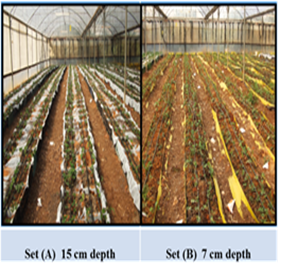 | Figure 1. The two soil depth sets experimentals image. Set (A) with 15 cm soil depth, and set (B) with 7 cm soil depth |
3. Result and Discussion
- The effects of organic protected agricultural area on living systems, particularly the effect on growth of plants, have been the objective of numerous researchers. The strawberry experiment carried out used compost mixed with agricultural sand as agricultural media. The results of soil analysis shown in Table 1. Our result showed that used mixed soil between compost and agricultural sand as agricultural media was a suitable media for growth strawberry plants and for productivity.
|
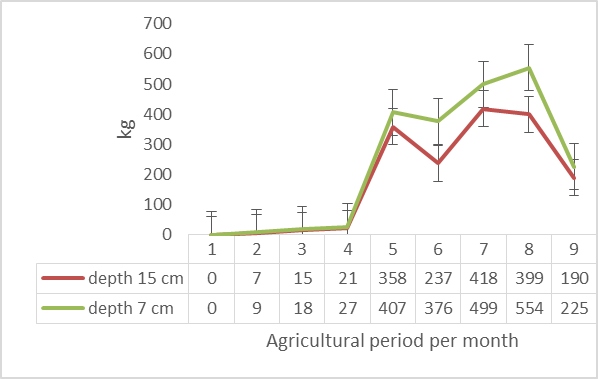 | Figure 2. Monthly strawberry productivity for the two experimental set |
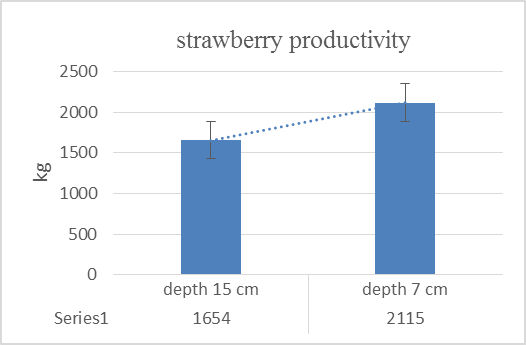 | Figure 3. The average agricultural seasons strawberry productivity for the two experimental set |
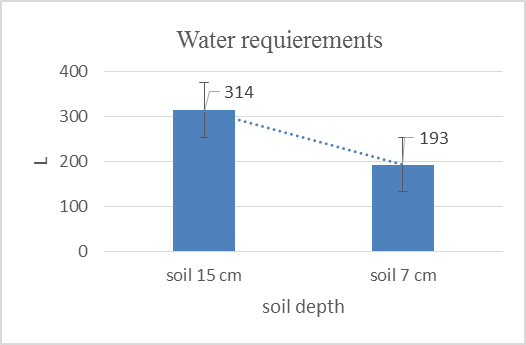 | Figure 4. The average water requirement for strawberry plants for the two experimental set |
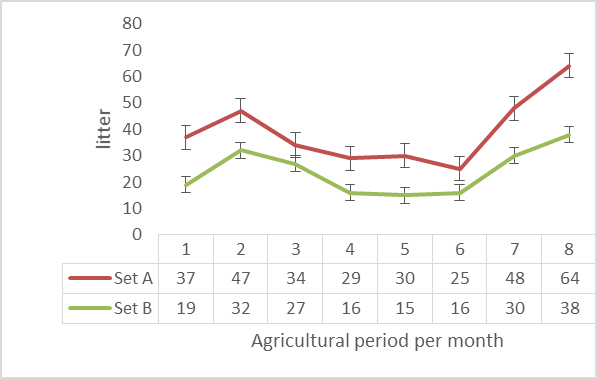 | Figure 5. Monthly water requirement for strawberry plants for the two experimental set |
|
4. Conclusions
- The mixture of compost and agricultural sand 50% for each is recommended for the cultivation of strawberries.Strawberry plants can grow in shallow soil depth and produce high quantity and quality according to the soil type, nutrition value, field capacity and aeration.The use of compost for the cultivation of strawberries caused a significant increase in fruit productivity, saving water and decreasing in fertilizers used.A high usefulness of the strawberry and field cultivation was in Set (B) were 7 cm soil depth in comparison with Set (A) were 15 cm soil depth, added it was a relation between the soil depth and fruit loses.
ACKNOWLEDGEMENTS
- Thanks are due to the Prof. Dr. Marwan Awartani, President, Palestine Technical University Kadoorie (PTUK) for generous support.
 Abstract
Abstract Reference
Reference Full-Text PDF
Full-Text PDF Full-text HTML
Full-text HTML